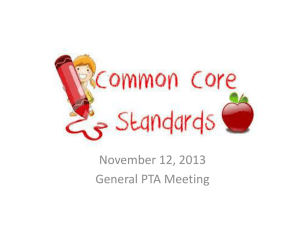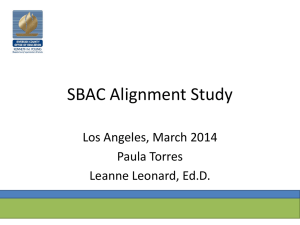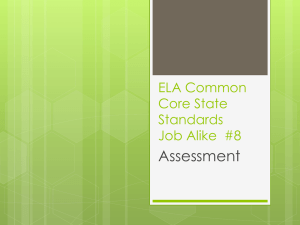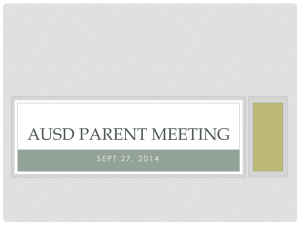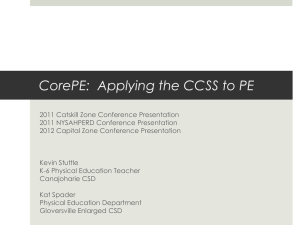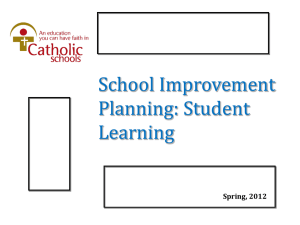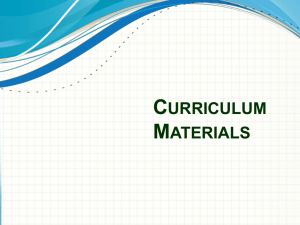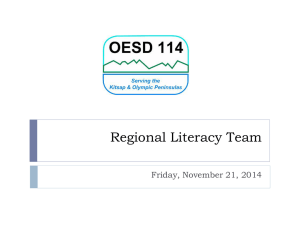Westhoff CC Parent Mtg_ 11 13
advertisement
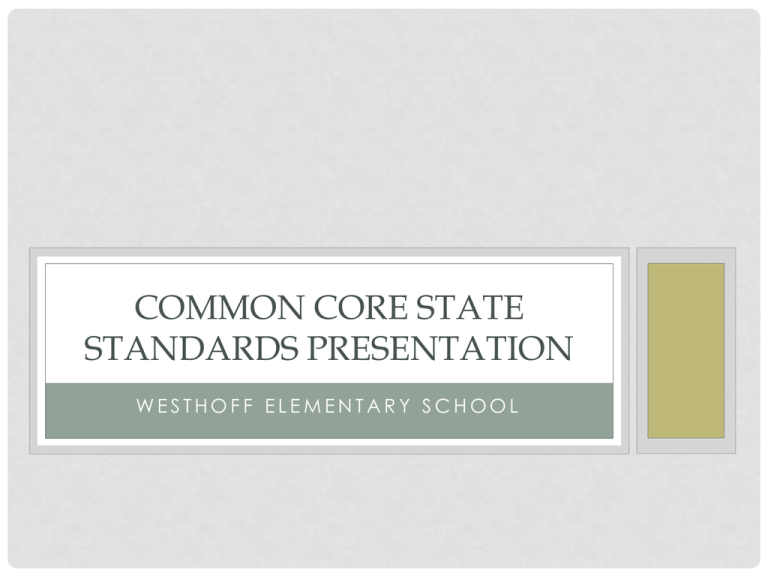
COMMON CORE STATE STANDARDS PRESENTATION WESTHOFF ELEMENTARY SCHOOL A MESSAGE FROM OUR STATE SUPERINTENDENT, DR. TOM TORLAKSON • California will provide a world-class education for all students, from early childhood to adulthood. The Department of Education serves our state by innovating and collaborating with educators, schools, parents, and community partners. Together, as a team, we prepare students to live, work, and thrive in a highly connected world. WHY NOW? • Disparity of standards across states • Student mobility • Global competition • Today’s jobs require different skills COMMON CORE GREAT CITIES VIDEO http://vimeo.com/51933492 COMMON CORE STATE STANDARDS • A state-led movement initiated through the National Governors Association and the Council of Chief State School Officers • The CCSS help define the knowledge and skills all students need to succeed in college and careers. • Expectations will be consistent for all students across the nation. WHAT ARE THE BENEFITS OF THE CCSS? • • • • Internationally benchmarked Student expectations are clear to parents, teachers, and the general public Allows for collaboration with other states on best practices, instructional materials, and professional development Reduces costs to the state THE COMMON CORE STATE STANDARDS • To date, forty-six states and the District of Columbia have adopted the Common Core State Standards (CCSS), a consistent set of English language arts (ELA) and mathematics expectations that students need to meet to succeed in college and careers • States have committed to implement the new standards by the 2014-15 school year • This is an aggressive timeline that will require a strategy that draws on state policymakers, district and school officials, and classroom teachers to ensure a successful and efficient implementation and transition THREE STAGES OF COMMON CORE • Awareness – Understanding the “Why” • Getting into the standards and supporting documents • Understanding the “shifts” • Transition – Curriculum Development • • • • Curriculum Maps, Materials and Documents Sample Lessons Assessments Instructional Methodology • Implementation • Practice and Refinement THE STRUCTURE OF THE CCSS – ENGLISH LANGUAGE ARTS • The standards are comprised of a set of Anchor Standards that are the same across K-12 and organized around four strands: • •Reading • •Listening & Speaking • •Writing • •Language SAMPLE ELA ANCHOR STANDARD FOR READING Read closely to determine what the text says explicitly to make logical inferences from it; cite specific textual evidence when writing or speaking to support conclusions drawn from the text 1. Kindergarten:1. With prompting and support, the student will ask and answer questions about key details in a text. 11-12thGrade: 1. Cite strong and thorough textual evidence to support analysis of what the text says explicitly as well as inferences drawn from the text, including determining where the text leaves matters uncertain. 6 SHIFTS IN ENGLISH LANGUAGE ARTS/LITERACY • • • • • • 1. Balancing Informational Text and Literacy Text 2. Knowledge in the Disciplines 3. Staircase of Complexity 4. Text-based Answers 5. Writing from Sources 6. Academic Vocabulary MATH SHIFTS • 1. Focus • 2. Coherence • 3. Fluency • 4. Deep understanding • 5. Application • 6. Dual Intensity 21ST CENTURY LEARNING • 21st Century Skills will be the highly visible aspect of the change in the classroom • WVUSD focusing on the 5C’s • Critical Thinking • Collaboration • Creativity • Communication • Citizenship WEBB’S DEPTH OF KNOWLEDGE CHART WE’VE ALREADY BEGUN! • Kindergarten and First Grade began implementing the Common Core State Standards at every site in 2012 • Transitional Kindergarten has developed a report card that mirrors the CCSS. • Grades 9, 10, 11 English Language Arts teachers have new textbooks written to the CCSS. • Staff Development has taken place for teachers at all levels. 2013-2014 IMPLEMENTATION • This year: • 2nd-12th grades have begun to implement the CCSS standards • Focus on instructional strategies using: • 5 C’s (Communication, Critical Thinking, Creativity, Collaboration and Citizenship) • Depth of Knowledge (DOK) • Shifts in ELA and math • Integration of content areas in units WESTHOFF MOVES FORWARD. . . . • K/1 teachers are in year two of CCSS implementation. Grades 2-12 have begun. • Common Core Teaching Strategies are linked to teacher’s professional growth plans. • Teachers attend Staff and professional development provided by our district office. • Staff Meeting time is allotted to CCSS. • Grade level Common Core days provided for cross vertical articulation. *Walnut Valley continues to provide indepth workshops and all grade levels have been represented. *Last summer grade levels (district wide) participated in workshops developing Common Core units of study. *Technology has doubled in past 2 years. Thanks in part to Community Club’s support. We now have an iPad cart for each grade level. *Teachers are providing opportunities for students to utilize the 5 C’s: Communication, Collaboration, Creativity, Critical Thinking and Citizenship across the curriculum. *Last year Westhoff participated in a pilot SBAC assessment in our third grade classes. *Teachers are: *Leading high level, text based discussions. *Focusing on process, not just content *Creating assignments for real audiences and with real purpose *Teaching argument, not persuasion *Increasing text complexity SMARTER BALANCED ASSESSMENT CONSORTIUM (SBAC) • SBAC will replace STAR/CST testing except in fifth, seventh and eleventh grade Science. • California schools will field test the SBAC this year. • Students in grade 3 – 11 will participate in SBAC. • “Testing of the test” will allow experts to discern the accuracy and reliability of test questions before finalizing the assessment. • No results will be reported this year. SUMMARY • The Common Core State Standards are about transforming our educational system by • preparing students with knowledge and skills to succeeding college and career • ensuring consistent expectations for students across the country • providing educators, parent and students with clear, focused guideposts • encouraging a shift in thinking—a new way to approach teaching QUESTIONS? For additional information, please go to smarterbalanced.org Cde.ca.gov Westhoff School Website has many Common Core parent resources • http://www.smarterbalanced.org/smarterbalanced-assessments/ • http://wvusd.k12.ca.us • • • • PARENT’S HOMEWORK • We encourage parents (and day care providers) to take the practice Smarter Balanced (SBAC) test. Go to your child’s grade level and see how the assessment differs from our paper pencil tests. • The website is available on the California Department of Education website. • http://www.smarterbalanced.org/. THANK YOU! • “Kids don’t care how much we know. . .Unless they know how much we care!” • Thank you for coming today and being partners with us in your child’s education.
